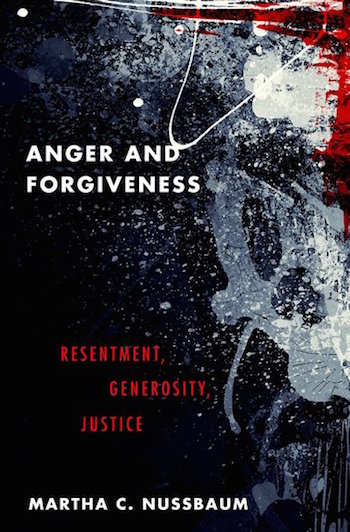Book Review: “Anger and Forgiveness” — Curb Your Choler
Although Anger and Forgiveness is a work of systematic philosophy in terms of its methodical traversal across varieties of anger and forgiveness, with definitions, it is also provocatively personal.
Anger and Forgiveness: Resentment, Generosity, Justice by Martha C. Nussbaum. Oxford University Press. 344 pp. $24.95
By David Mehegan

You know a thinker is distinguished when the very word is imbedded in her job title. Martha C. Nussbaum, author of many books on ethics and society, is the Ernst Freund Distinguished Service Professor of Law and Ethics at the University of Chicago, “appointed,” Oxford Press reminds us, “in the Law School, the Philosophy Department and the Divinity School.” All of which is to say that your humble reviewer approaches his task with a light tread.
But the book with such a formidable title turns out to have a fairly plain and straightforward thesis, spelled out early and repeated often. It is that anger, which everyone feels and which most organized religion, society, and contemporary psychology defends as appropriate, most of the time is “normatively problematic.” This clunky phrase, undoubtedly found in the moral philosopher’s glossary, seems to mean that letting anger lead our acts is irrational, useless, and damaging.
Anger is undeniably part of the human makeup, Nussbaum avers, and she plots its usual genesis and function. We get angry when we see the offense of another as lowering our relative status; viz. the idiom “put-down.” Our impulse toward vengeance (which Nussbaum calls “the road of payback”) seeks to redress the proper status relationship. If my teenage son were to speak to me in an insulting or disrespectful way — my example, not Nussbaum’s — it makes me angry (“You can’t talk to me that way!”) and prompts me to take some sort of retributive action that restores in my mind the correct status relationship.
Along with the status-redress drive is that toward a sense of balance: hence the image of blind justice with her scales. For many who believe in capital punishment, the objective is not deterrence or any kind of solution to serious crime; it is the abstract redress of a moral balance, the ancient law of lex talionis. “He took a life and must pay with his own,” intoned Hudson the butler in the old Upstairs, Downstairs TV series. “That is the law of civilized man.” In commonplace psychology, it is believed that the recognition and “ownership” of anger — toward parents, a spouse, an employer, or co-worker — is an emotionally healthful instinct preferable to self-suppression of anger. We have a right to be angry, we say, and so we should let it out.
Nussbaum briskly rejects all of these arguments on the most practical grounds: they’re irrational, “magical thinking,” they just don’t work. “We could agree,” she writes, “that the disruption of social order is bad and that the desire to protect people from wrongful damages is good, without buying into the payback idea or thinking, magically, that returning pain for pain achieves anything.” Vengeance, whether individual or legalized, often unleashes a downward cycle that leads to endless feuding and reenactment of offense.
Consider the driver consumed by rage when he is cut off in traffic, who pursues the offender with determination to pay him back, often by violence. What does he gain, what does anyone gain, if he is successful? Not a thing. On the level of individual or social policy, the insistence on rigid, tit-for-tat punishment does not solve the underlying behavioral problem, however good it might temporarily make us feel. As for anger at being “dissed” or put down, relative status is an abstraction that can never be properly established to begin with; endless trying to pull up one’s own in relation to all or some others is a fool’s errand. In terms of mental health, the open expression of anger, on the grounds that one has a right to be angry, usually does not make one feel better in the long run, sometimes worse. However natural and normal, however we must acknowledge our valid reasons to feel it, anger is most often destructive.
What then should we do? Nussbaum advocates what she calls “transition-anger” — the conversion of reasonable anger to some form of practical movement toward solution of the underlying problem. When converted to transition, “anger quickly puts itself out of business, in that even the residual focus on punishing the offender is soon seen as part of a set of projects for improving both offenders and society.” In contrast with traditional anger, “Transition-Anger does not focus on status; nor does it, even briefly, want the suffering of the offender as a type of payback for the injury. It never gets involved at all in that type of magical thinking. It focuses on social welfare from the start.”
This is the essence of her argument, though I simplify greatly by leaving out her extensive exploration of classical and philosophical understandings of anger: by the ancient Greeks, Seneca and Aristotle, by religious and secular philosophers from St. Augustine and Maimonides to such modern thinkers as Gandhi, Martin Luther King, Jr., Charles Griswold, and Nelson Mandela. She includes a wide-ranging sampling of anger in literature, from Aeschylus’s Oresteia and Seneca’s Medea through the fiction of Anthony Trollope and Charles Dickens, to Iris Murdoch, Philip Roth, and even current TV situation comedies and Jeff Kinney’s Diary of a Wimpy Kid. The Stoic philosophers, especially Seneca, inspire much of her argument, though she does not endorse their cold ideas about the pointlessness of human attachments. Although her title names five human impulses, anger is the forerunner. Anger raises the possibility of forgiveness, resentment, generosity, and justice, and Nussbaum subjects each to definitive analysis: what do they mean? how do they work? when are they appropriate? Each is analyzed in terms of its connection with transition-anger.
Most of the book focuses on the dynamics and philosophical analysis of anger, but Nussbaum gives considerable attention as well to forgiveness. She does not think much of the “forgive and forget” variety of forgiveness, beloved of some major religions — the sort that shrugs and tries to gloss over the offense, without resolving the underlying problem. She does not think that prisons should simply be closed and crime brushed away. Rather, anger at real misdoing, large or small, can be useful if the response, even a punitive one, leads to a higher and better level of existence: “As Plato says: the person who punishes rationally does not punish for the sake of a past injustice, but rather for the sake of the future.”
Although Anger and Forgiveness is a work of systematic philosophy in terms of its methodical traversal across varieties of anger and forgiveness, with definitions, it is also provocatively personal. Not that Nussbaum’s personal history is given, but that examples from her life play a part. She makes clear that she did not always hold her present views. “In the intimate domain,” she writes “even people otherwise sympathetic to a critique of anger often hold that anger is morally right and justified. (I used to hold this view.)”
Her personal anecdotes are compelling. She tells the story of a man on a plane (she notes that she was returning home from giving the prestigious John Locke Lectures in Philosophy at Oxford) who moved to take her small carry-on suitcase from her and put it in the overhead bin, heedless that she did not ask for help.

Martha C. Nussbaum — for her, letting anger lead our acts is irrational, useless, and damaging. Photo: Wiki Commons
“I said, ‘No thank you,’ and was about to thank him for asking — when, and by this time the bag was already in, he grabbed it and shoved it in further. I said, politely, ‘If you were going to do it anyway, why did you ask?’ He said he was a German trauma surgeon and had ‘lots of experience with patients who…’ — then he stopped, seeing something in my face, perhaps, that reminded him that I was not his patient. I said, somewhat less politely, that I do not spend hours lifting weights in the gym each day only to be insulted, and I bet I could overhead-press more weight that he could (since, though large, he was not in good shape). Obviously he was the sort of doctor, and surgeons are often of this sort, who has no interest in the individual history of the patient. He must have been thinking of all those faceless women — necks and shoulders merely — who had injured themselves in such activities, very likely without daily weight training. Nonetheless I really was angry, and my response was pretty stupid. I was so mad that I asked the stewardess if she could change my seat. … I continued to seeth, even two weeks later.”
While this incident is put to use in a philosophical way — she goes on to argue coolly how “ridiculous and disproportionate” her responses were — it reveals a good deal about the flesh-and-blood person who is making all these well-buttressed arguments. Her reaction struck me as extreme, and she did not seem to consider that the man might not have been motivated by a desire to lower her status (as the Locke Lecturer in Philosophy). Perhaps he was trained by his mother, as I was by mine, to an impulsive old-fashioned chivalry on public conveyances. His kind of male presumption is clearly a sore point with her. Later on, she let us in on a bald prejudice: “Men in particular think that they have achieved something if they can make a woman mad, particularly if she is calm and intellectual. Often, they use the attempt to make you mad as a way of flirting, no doubt thinking that unlocking the pent-up emotions of such a woman is a sexual victory.” Not “many men,” notice, nor “certain men I’ve known,” but “men.” It would appear that plenty of men have thus flirted with “you,” that is, her.
I mean no put-down. That Nussbaum acknowledges and reveals that she has quirks and sensitivities of her own is an appealing trait, or so it seemed to me. In the end, she uses her own anger as much as anyone else’s, whether merited or not, to return to the dispassionate point: “The idea that the ability to forgo retribution is a mark of both personal and societal strength is a persistent leitmotif of the present book.” It is clear that much of what she argues from a systematic rational standpoint is in large part a hard-won wisdom at what helps make life better and what just makes a botch of things. “If this book achieves anything,” she writes, “I hope It achieves that sort of square-one reorientation, getting its readers to see clearly the irrationality and stupidity of anger….I don’t always take my own medicine, succumbing to the lure of thinking that the world of airlines, banks, and Internet repair people ought to be rational, and yielding to anger when (predictably) the real world does not meet that expectation. It’s hard not to be stupid.”
I suppose this is the sort of thing often said by the laity of very smart books by very smart scholars, but it seemed to me that Martha C. Nussbaum has surveyed in this book some wisdom that is not actually all that remarkable or even original. Getting beyond anger to some sort of better settlement of differences is the heart of all diplomacy, all peacemaking. The wise have always known this. Still, it is useful to read the argument extensively developed, supported, and brought to the conclusion many of us might have already reached. The need for it is undeniable, as is Nussbaum’s point that it’s hard not to be stupid.
David Mehegan is a contributing writer. He can be reached at dmehegan@gmail.bu.edu.
Tagged: Anger and Forgiveness: Resentment, Generosity, Justice, Martha C. Nussbaum, Oxford University Press
